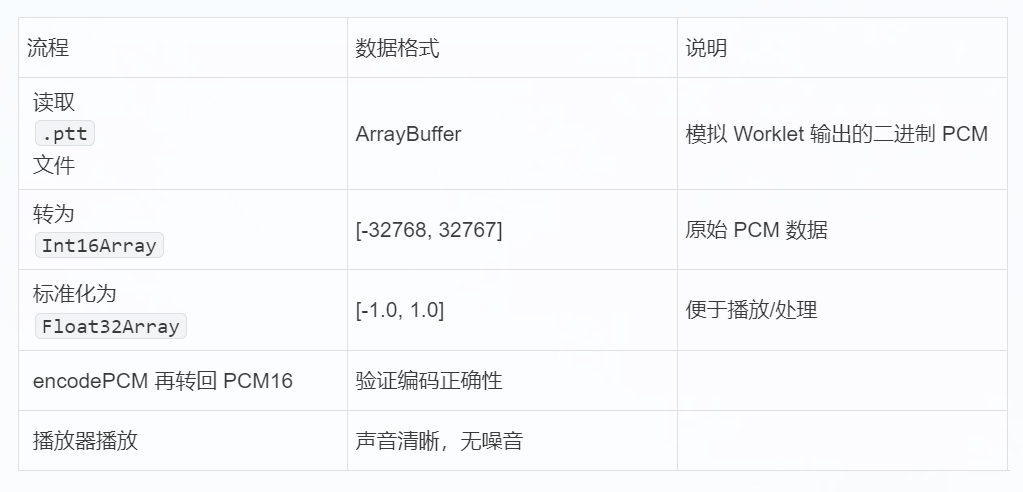连这条博客(【electron6】浏览器实时播放PCM数据)
一、背景与目标
在语音识别或实时通话类项目中,我们通常需要通过 AudioWorkletNode 从麦克风采集音频数据,并将其转换为标准 16bit PCM(线性脉冲编码调制)格式,以便传输或播放。为了调试 Worklet 数据处理流程,本笔记中使用一个本地 PCM 文件 (.ptt) 来模拟 AudioWorkletNode.process() 的输出数据,从而快速验证 PCM ↔ Float32 转换链路是否正确、是否干净无噪音。
二、音频采集基础结构
显式指定 sampleRate = 16000,保证采样率一致性:
this.audioCtx = new AudioContext({
sampleRate: 16000
});
await this.audioCtx.audioWorklet.addModule('./voice.js');
this.randomNoiseNode = new AudioWorkletNode(
this.audioCtx,
"voices",
{
channelCount: 1,
processorOptions: {
recording: this.recording,
targetSampleRate: 16000,
frameSize: 320, // 每帧 20ms
},
parameterData: {
customGain: 1.0
}
}
);三、AudioWorkletProcessor 核心实现
Worklet 内部负责实时从输入流读取音频、缓存、打包并发送至主线程:
class VoicesProcessor extends AudioWorkletProcessor {
constructor(options) {
super();
this.buffer = [];
this.recording = options.processorOptions.recording;
this.frameSize = options.processorOptions.frameSize || 320;
}
encodePCM(float32Array) {
const buffer = new ArrayBuffer(float32Array.length * 2);
const view = new DataView(buffer);
let offset = 0;
for (let i = 0; i < float32Array.length; i++, offset += 2) {
let s = Math.max(-1, Math.min(1, float32Array[i]));
view.setInt16(offset, s < 0 ? s * 0x8000 : s * 0x7FFF, true);
}
return view;
}
process(inputs, outputs) {
const input = inputs[0][0];
if (!input) return true;
// 将每次 process 的 128 采样块累计缓存
this.buffer.push(...input);
// 达到一帧长度(320 samples = 20ms@16kHz)时发送
if (this.buffer.length >= 320) {
const frame = this.buffer.slice(0, 320);
this.buffer = this.buffer.slice(320);
const bytes = this.encodePCM(new Float32Array(frame));
this.port.postMessage({ type: 'result', data: bytes });
}
return this.recording;
}
}
registerProcessor('voices', VoicesProcessor);四、encodePCM 函数(Float32 → PCM16)
const encodePCM = (float32Array: Float32Array) => {
const buffer = new ArrayBuffer(float32Array.length * 2);
const view = new DataView(buffer);
let offset = 0;
for (let i = 0; i < float32Array.length; i++, offset += 2) {
let s = Math.max(-1, Math.min(1, float32Array[i]));
view.setInt16(offset, s < 0 ? s * 0x8000 : s * 0x7FFF, true);
}
return view;
};五、文件模拟 Worklet 数据调试
使用本地 .ptt(其他的.pcm文件也可) PCM 文件模拟 AudioWorkletNode 输出数据:
import axios from 'axios';
const onePcm = require('./ceshi.ptt');
const encodePCM = (float32Array: Float32Array) => {
const buffer = new ArrayBuffer(float32Array.length * 2);
const view = new DataView(buffer);
let offset = 0;
for (let i = 0; i < float32Array.length; i++, offset += 2) {
let s = Math.max(-1, Math.min(1, float32Array[i]));
view.setInt16(offset, s < 0 ? s * 0x8000 : s * 0x7FFF, true);
}
return view;
}
useEffect(() => {
axios({
url: onePcm,
method: 'get',
responseType: 'arraybuffer'
}).then(res => {
const int16Array = new Int16Array(res.data);
const float32Array = new Float32Array(int16Array.length);
// Int16 → Float32 标准化
for (let i = 0; i < int16Array.length; i++) {
let s = Math.max(-1, Math.min(1, int16Array[i]));
float32Array[i] = s < 0 ? int16Array[i] / 0x8000 : int16Array[i] / 0x7FFF;
}
// 模拟 Worklet 内 encodePCM 再还原
const decodeView = encodePCM(float32Array);
// 使用自定义播放器播放
let voice = new ProcessPCM();
voice.playback(decodeView, () => {
console.log('PCM 播放结束');
});
});在这里插入图片描述
}, []);六、噪音原因与解决总结
流程数据格式说明

七、噪音的本质原因复盘
原因描述

八、最终效果总结
优化点效果
